July 2020
THE DISTRIBUTION BULLETIN ISSUE #41
26/Jul/2020
ONE VIRTUAL PREMIERE, ONE MILLION VIEWS
by Peter Broderick
Attention Guinness World Records: During its 3-day virtual premiere, Five Seasons was viewed over 1 million times around the world. No distributor required.
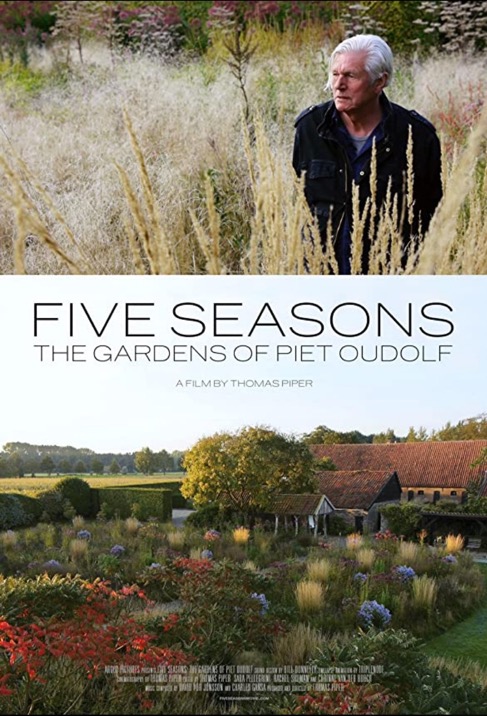
This documentary about garden design attracted a larger audience in a single weekend than most documentaries ever achieve in their entire lifetimes.
Five Seasons powerfully demonstrates the unprecedented potential of virtual screenings.
I define a virtual screening as the online availability of a film during a limited time period (usually 2-72 hours). Unlike physical screenings that are limited to a single venue with a certain number of seats, virtual screenings can be viewed worldwide by an unlimited number of people.
FIVE SEASONS PHYSICAL DISTRIBUTION
Shot, produced, and directed by Tom Piper, Five Seasons shows how “the revolutionary landscape designer, Piet Oudolf, upends our conventional notions of nature, public space, and, ultimately, beauty itself.” I’ve been consulting with Tom on the distribution of Five Seasons in North America and abroad for three years. Tom has diligently implemented a customized distribution strategy stage-by-stage. The film was distributed theatrically in North America by Argot Pictures. It is distributed in the UK by Dartmouth Films. It did very well in Australian theaters without a distributor. Working without a foreign sales agent, Tom continued to book many physical festival and special event screenings around the world.

Tom Piper shooting. Photo: Malcolm Wyer
FIVE SEASONS VIRTUAL DISTRIBUTION
Earlier this year, the devastating spread of Covid-19 made it impossible to do any more physical screenings. Then, on April 9, 2020, Tom received an invitation for the virtual premiere of Five Seasons from Hauser & Wirth, the global art gallery.
Piet Oudolf had landscaped the gallery’s location in Somerset, England. Hauser & Wirth had previously done physical screenings of the film at six of its galleries around the world, including Somerset. It was enthusiastic about Five Seasons and eager to present the virtual premiere via its website.
Tom quickly accepted their offer. On Earth Day (April 22nd), Hauser & Wirth sent their newsletter to 50,000 subscribers around the world announcing the free digital premiere of Five Seasons during the following weekend (April 24-26). They supported the event with some social media posts and ads and a second email blast on Saturday. They also generated some press coverage in Town & Country and Gardens Illustrated.

Drone shot of Oudolf Field at Hauser & Wirth Somerset.
Photo: Film still from Five Seasons
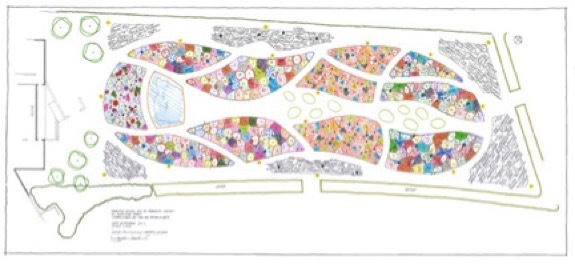
Planting design for Oudolf Field at Hauser & Wirth Somerset.
Credit: Piet Oudolf
The response was overwhelming. 1 million views equal 1.5 million viewers, assuming many views were by 2 or more people. The average viewing time was a remarkable 71 minutes, meaning that almost all viewers watched the full, 75-minute film, with or without end credits. Viewership was widely dispersed among more than 50 countries. Here’s a global view highlighting the top ten countries.

Credit: Hauser & Wirth
Views in the top ten territories were:
U.S.xxxxxxxxxxxxxxxxxx343,604
U.K.xxxxxxxxxxxxxxxxxx196,992
Australiaxxxxxxxxxx xxxxx43,269
Brazilxxxxxxxxxxxxx xxx x42,999
Argentinaxxxxxxxxxx xxxx39,159
Israelxxxxxxxxxxxxxxxxxx29,906
Italyxxxxxxxxxxxx xxxxx x26,767
Swedenxxxxx. x xxxxxxxxx26,181
Bulgariaxxxxx. xxxxxxxxxx22,317
Netherlandsxxx. xxxxxxxxx22,282
Tom was thrilled that so many people in so many countries watched his film. He was also really gratified that – in this era of so many choices available online and such short attention spans—so many viewers watched his film from beginning to end.
The benefits to him included:
This will enable him to build a long life for the film and maximize revenues. More importantly, this will enhance his opportunities to make more films and to have a sustainable career.
OLD WORLD vs. NEW WORLD
To understand the potential of virtual screenings, it is helpful to juxtapose their essential elements with those of traditional physical screenings. This chart compares Old World physical screenings with New World virtual screenings.
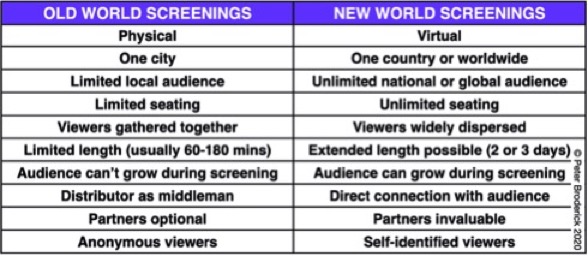
This chart overlaps in several ways with my chart contrasting Old World Festivals with New World Festivals.
Among the key differences are:
VIRTUAL SCREENING STRATEGY
1. Partners are Key
A great partner can connect your film with a substantial core audience. Hauser & Wirth was an ideal partner for Five Seasons. They highlighted the film twice to their 50,000 subscribers around the world and supported it with social media. News of the upcoming screening went viral as people alerted others during the 2 days leading up to the screening. Then people started watching it and sharing their enthusiasm with others. There were 500,000 views during the first half of the screening window and another 500,000 during the second half.
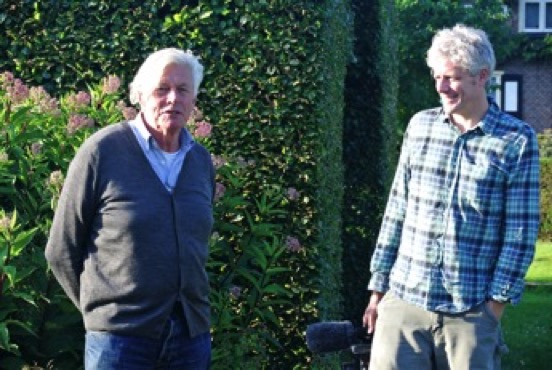
Piet Oudolf and Tom Piper. Photo: Malcolm Wyer
Partners are essential to maximizing the distribution of documentaries (see my partner Keith Ochwat’s special report on Harnessing Partnerships). Virtual screenings are a perfect example of this. Organizations can bring their members and supporters. Companies can bring their customers. Influencers can bring their followers. Government agencies can bring the public. Educational institutions can bring faculty and students. Inviting or alerting people to a virtual screening requires little time or effort.
2. Private Virtual Screenings
The benefits and limitations of public and private virtual screenings are quite different. This has historically also been true for physical screenings. Physical screenings limited to cast and crew, members of an organization, or attendees at a conference not open to the public are considered private and do not interfere with festival premieres.
The same distinction should apply to virtual screenings. If they aren’t advertised to the public and the public can’t attend, they are private.
Private virtual screenings are an unprecedented new tool that can empower filmmakers. These screenings are not limited by windows. They can be done before, during, and after the festival window. They can also be done during all other windows, including theatrical, educational, and consumer. They are not limited by venue or seating. They can be local, national, and global.
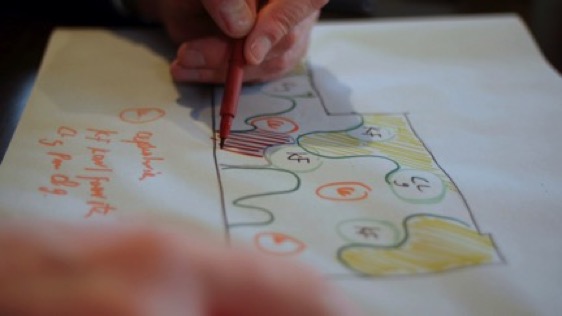
Piet Oudolf drawing a garden plan. Photo: Film still from Five Seasons
3. Succeeding with core audiences
To succeed, documentary filmmakers must be able to define, test, and effectively reach core audiences. Virtual screenings are a perfect way to do this.
The enormous response to Five Seasons was a revelation. Tom had previously focused on the very large garden audience and they showed up beyond his wildest imaginings. Growing in a few days from an alert to 50,000 people to an estimated total audience of 1.5 million demonstrated their level of enthusiasm.
The screening also enabled Five Seasons “to jump the fence and go beyond its core audience,” as Tom explained. “Piet’s appeal transcends the garden world.” He also has fans in the art, design, architecture, and fashion worlds, who were attracted to the virtual premiere.
Many filmmakers make mistaken assumptions about their core audiences. Virtual screenings are an ideal way to test these assumptions and determine which audiences are responding.
4. Maximizing awareness
No film will achieve its full potential if it doesn’t reach a critical level of awareness. Virtual screenings are a great way to increase awareness of a film.
Five Seasons had been seen by an estimated 50,000 viewers as of the end of 2019, after one and a half years of distribution in North America, according to Tom’s rough calculation. 30 times as many viewers saw the film during its three-day virtual screening. This increased global awareness of Five Seasons exponentially.
It is an important reminder of “the power of free”. No admission was charged so there was no cost to sample the film. Once a film achieves a substantial amount of awareness, it can have a life for years to come.

Piet Oudolf. Photo: Film still from Five Seasons
5. Maximizing revenue
There are many ways virtual screenings can produce meaningful revenues for filmmakers:
6. Maximizing impact
Virtual screenings are a great tool to catalyze impact. A film can be shown to:
7. Maximizing career
Virtual screenings can be used to expand a filmmaker’s personal audience. The larger a personal audience, the greater the chances of having a sustainable career. If a filmmaker does not automatically receive the names and emails of everyone who watches their film during a virtual screening, they can encourage them to opt in to their mailing list.
8. Invaluable uses
Virtual screenings have as many possible uses as a Swiss Army knife. In addition to those already described, they can be used for:
Virtual screenings give you the possibility to create a compelling special event that people will be excited to be part of. This is very different from just sending someone a link that they may get around to watching at some point.
9. The speed of virtual
Tom learned how much faster things can happen in the New World of Distribution. His successful US theatrical premiere took six months to plan and prepare. Then Five Seasons had another 218 bookings across North America during the next 21 months. His virtual premiere was arranged 10 days in advance and announced 2 days before it began. As soon as the virtual screening started, viewers could share links with friends who could immediately watch Five Seasons.
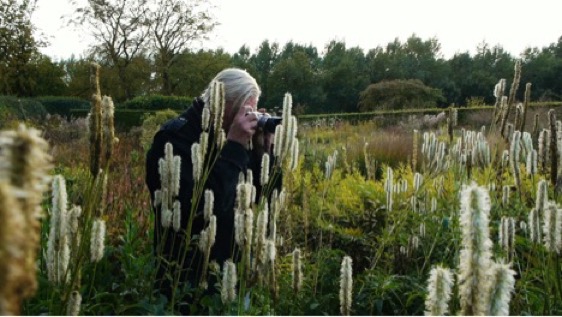
Piet in his own garden in Hummelo, Netherlands. Photo: Film still from Five Seasons
10. No gatekeepers
Independent filmmakers are constantly seeking the support of gatekeepers –investors, funders, agents, festival programmers, exhibitors, distributors, and film critics- so they can make their films and bring them into the world. Almost everywhere they look there are intermediaries between them and the audience they want to reach.
Virtual screenings give them the opportunity to connect directly with audiences. They don’t need approval or permission. No one can stop them.
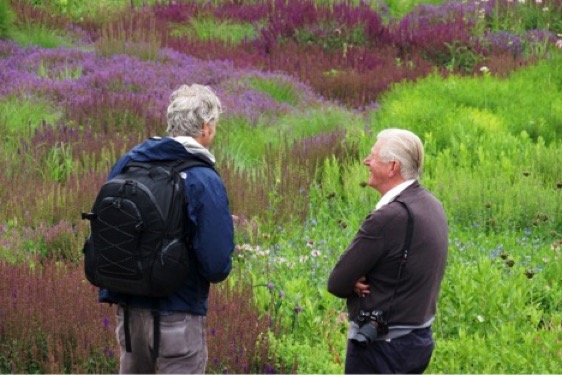
Piet Oudolf and Tom Piper in The Lurie Garden, Chicago.
Photo: Adam Woodruff
The pandemic has stopped physical film festivals, closed movie theaters, and halted nontheatrical screenings. Many filmmakers feel stuck in a crushing limbo, anxiously waiting to advance their projects.Virtual screenings are a new avenue to audiences. They are pandemic proof. They provide a way forward in these dark times.

Piet’s own garden in Hummelo. Photo: Film still from Five Seasons
© 2020 Peter Broderick
by Peter Broderick
Attention Guinness World Records: During its 3-day virtual premiere, Five Seasons was viewed over 1 million times around the world. No distributor required.

This documentary about garden design attracted a larger audience in a single weekend than most documentaries ever achieve in their entire lifetimes.
Five Seasons powerfully demonstrates the unprecedented potential of virtual screenings.
I define a virtual screening as the online availability of a film during a limited time period (usually 2-72 hours). Unlike physical screenings that are limited to a single venue with a certain number of seats, virtual screenings can be viewed worldwide by an unlimited number of people.
FIVE SEASONS PHYSICAL DISTRIBUTION
Shot, produced, and directed by Tom Piper, Five Seasons shows how “the revolutionary landscape designer, Piet Oudolf, upends our conventional notions of nature, public space, and, ultimately, beauty itself.” I’ve been consulting with Tom on the distribution of Five Seasons in North America and abroad for three years. Tom has diligently implemented a customized distribution strategy stage-by-stage. The film was distributed theatrically in North America by Argot Pictures. It is distributed in the UK by Dartmouth Films. It did very well in Australian theaters without a distributor. Working without a foreign sales agent, Tom continued to book many physical festival and special event screenings around the world.

Tom Piper shooting. Photo: Malcolm Wyer
FIVE SEASONS VIRTUAL DISTRIBUTION
Earlier this year, the devastating spread of Covid-19 made it impossible to do any more physical screenings. Then, on April 9, 2020, Tom received an invitation for the virtual premiere of Five Seasons from Hauser & Wirth, the global art gallery.
Piet Oudolf had landscaped the gallery’s location in Somerset, England. Hauser & Wirth had previously done physical screenings of the film at six of its galleries around the world, including Somerset. It was enthusiastic about Five Seasons and eager to present the virtual premiere via its website.
Tom quickly accepted their offer. On Earth Day (April 22nd), Hauser & Wirth sent their newsletter to 50,000 subscribers around the world announcing the free digital premiere of Five Seasons during the following weekend (April 24-26). They supported the event with some social media posts and ads and a second email blast on Saturday. They also generated some press coverage in Town & Country and Gardens Illustrated.

Drone shot of Oudolf Field at Hauser & Wirth Somerset.
Photo: Film still from Five Seasons

Planting design for Oudolf Field at Hauser & Wirth Somerset.
Credit: Piet Oudolf
The response was overwhelming. 1 million views equal 1.5 million viewers, assuming many views were by 2 or more people. The average viewing time was a remarkable 71 minutes, meaning that almost all viewers watched the full, 75-minute film, with or without end credits. Viewership was widely dispersed among more than 50 countries. Here’s a global view highlighting the top ten countries.

Credit: Hauser & Wirth
Views in the top ten territories were:
U.S.xxxxxxxxxxxxxxxxxx343,604
U.K.xxxxxxxxxxxxxxxxxx196,992
Australiaxxxxxxxxxx xxxxx43,269
Brazilxxxxxxxxxxxxx xxx x42,999
Argentinaxxxxxxxxxx xxxx39,159
Israelxxxxxxxxxxxxxxxxxx29,906
Italyxxxxxxxxxxxx xxxxx x26,767
Swedenxxxxx. x xxxxxxxxx26,181
Bulgariaxxxxx. xxxxxxxxxx22,317
Netherlandsxxx. xxxxxxxxx22,282
Tom was thrilled that so many people in so many countries watched his film. He was also really gratified that – in this era of so many choices available online and such short attention spans—so many viewers watched his film from beginning to end.
The benefits to him included:
- a screening fee
- the addition of 3100 new subscribers to his mailing list and personal core audience
- hundreds of requests from organizations and individuals, which will turn into paid screenings and sales. Tom has a section of his website devoted to helping organizations and individuals “organize a virtual screening”.
- an amazing increase in worldwide awareness of Five Seasons
This will enable him to build a long life for the film and maximize revenues. More importantly, this will enhance his opportunities to make more films and to have a sustainable career.
OLD WORLD vs. NEW WORLD
To understand the potential of virtual screenings, it is helpful to juxtapose their essential elements with those of traditional physical screenings. This chart compares Old World physical screenings with New World virtual screenings.

This chart overlaps in several ways with my chart contrasting Old World Festivals with New World Festivals.
Among the key differences are:
- the greater possible length of virtual screenings allows enough time for digital word-of-mouth to significantly expand the audience. I assume that many viewers who watched Five Seasons during the first day or two raved about it to others, significantly expanding the audience during the last day or two of the screening.
- making the film available during a limited time period gives a virtual screening the feeling of a special event (as opposed to continuing availability on VOD). There was a spike in viewership Sunday night as time was running out.
- many physical screenings are organized by distributors, who act as intermediaries between filmmakers and screening audiences. When filmmakers organize virtual screenings, they can have a much more direct connection with the audience. Viewers reached out to Tom on Instagram and he was able to engage with them in more satisfying ways than if they just asked questions during a Q and A following a physical screening.
VIRTUAL SCREENING STRATEGY
1. Partners are Key
A great partner can connect your film with a substantial core audience. Hauser & Wirth was an ideal partner for Five Seasons. They highlighted the film twice to their 50,000 subscribers around the world and supported it with social media. News of the upcoming screening went viral as people alerted others during the 2 days leading up to the screening. Then people started watching it and sharing their enthusiasm with others. There were 500,000 views during the first half of the screening window and another 500,000 during the second half.

Piet Oudolf and Tom Piper. Photo: Malcolm Wyer
Partners are essential to maximizing the distribution of documentaries (see my partner Keith Ochwat’s special report on Harnessing Partnerships). Virtual screenings are a perfect example of this. Organizations can bring their members and supporters. Companies can bring their customers. Influencers can bring their followers. Government agencies can bring the public. Educational institutions can bring faculty and students. Inviting or alerting people to a virtual screening requires little time or effort.
2. Private Virtual Screenings
The benefits and limitations of public and private virtual screenings are quite different. This has historically also been true for physical screenings. Physical screenings limited to cast and crew, members of an organization, or attendees at a conference not open to the public are considered private and do not interfere with festival premieres.
The same distinction should apply to virtual screenings. If they aren’t advertised to the public and the public can’t attend, they are private.
Private virtual screenings are an unprecedented new tool that can empower filmmakers. These screenings are not limited by windows. They can be done before, during, and after the festival window. They can also be done during all other windows, including theatrical, educational, and consumer. They are not limited by venue or seating. They can be local, national, and global.

Piet Oudolf drawing a garden plan. Photo: Film still from Five Seasons
3. Succeeding with core audiences
To succeed, documentary filmmakers must be able to define, test, and effectively reach core audiences. Virtual screenings are a perfect way to do this.
The enormous response to Five Seasons was a revelation. Tom had previously focused on the very large garden audience and they showed up beyond his wildest imaginings. Growing in a few days from an alert to 50,000 people to an estimated total audience of 1.5 million demonstrated their level of enthusiasm.
The screening also enabled Five Seasons “to jump the fence and go beyond its core audience,” as Tom explained. “Piet’s appeal transcends the garden world.” He also has fans in the art, design, architecture, and fashion worlds, who were attracted to the virtual premiere.
Many filmmakers make mistaken assumptions about their core audiences. Virtual screenings are an ideal way to test these assumptions and determine which audiences are responding.
4. Maximizing awareness
No film will achieve its full potential if it doesn’t reach a critical level of awareness. Virtual screenings are a great way to increase awareness of a film.
Five Seasons had been seen by an estimated 50,000 viewers as of the end of 2019, after one and a half years of distribution in North America, according to Tom’s rough calculation. 30 times as many viewers saw the film during its three-day virtual screening. This increased global awareness of Five Seasons exponentially.
It is an important reminder of “the power of free”. No admission was charged so there was no cost to sample the film. Once a film achieves a substantial amount of awareness, it can have a life for years to come.

Piet Oudolf. Photo: Film still from Five Seasons
5. Maximizing revenue
There are many ways virtual screenings can produce meaningful revenues for filmmakers:
- admission can be charged. If viewing Five Seasons had cost $2.00 and there were 250,000 views, the gross would have been $500,000.
- a screening can be a fundraiser. If the price had been $10.00 and there had been 100,000 views, the gross would have been $1 million, 50% to the partner and 50% to the filmmaker.
- a filmmaker can be paid a fee by the partner organization to make the film available to its members (these fees can range from $250 to $5,000 and up).
- filmmakers can sell online downloads, streams, tool kits, and other ancillaries following the screening.
6. Maximizing impact
Virtual screenings are a great tool to catalyze impact. A film can be shown to:
- policymakers and their staffs
- members of an organization to get them involved with an issue
- funders to attract their support for a campaign
7. Maximizing career
Virtual screenings can be used to expand a filmmaker’s personal audience. The larger a personal audience, the greater the chances of having a sustainable career. If a filmmaker does not automatically receive the names and emails of everyone who watches their film during a virtual screening, they can encourage them to opt in to their mailing list.
8. Invaluable uses
Virtual screenings have as many possible uses as a Swiss Army knife. In addition to those already described, they can be used for:
- test screenings followed by in-depth Zoom conversations with audiences as geographically dispersed as desired
- press screenings followed by substantive Q and A’s with critics across the country or around the world
- special screenings for funders and supporters, ranging from investors to Kickstarter donors
Virtual screenings give you the possibility to create a compelling special event that people will be excited to be part of. This is very different from just sending someone a link that they may get around to watching at some point.
9. The speed of virtual
Tom learned how much faster things can happen in the New World of Distribution. His successful US theatrical premiere took six months to plan and prepare. Then Five Seasons had another 218 bookings across North America during the next 21 months. His virtual premiere was arranged 10 days in advance and announced 2 days before it began. As soon as the virtual screening started, viewers could share links with friends who could immediately watch Five Seasons.

Piet in his own garden in Hummelo, Netherlands. Photo: Film still from Five Seasons
10. No gatekeepers
Independent filmmakers are constantly seeking the support of gatekeepers –investors, funders, agents, festival programmers, exhibitors, distributors, and film critics- so they can make their films and bring them into the world. Almost everywhere they look there are intermediaries between them and the audience they want to reach.
Virtual screenings give them the opportunity to connect directly with audiences. They don’t need approval or permission. No one can stop them.

Piet Oudolf and Tom Piper in The Lurie Garden, Chicago.
Photo: Adam Woodruff
The pandemic has stopped physical film festivals, closed movie theaters, and halted nontheatrical screenings. Many filmmakers feel stuck in a crushing limbo, anxiously waiting to advance their projects.Virtual screenings are a new avenue to audiences. They are pandemic proof. They provide a way forward in these dark times.

Piet’s own garden in Hummelo. Photo: Film still from Five Seasons
© 2020 Peter Broderick